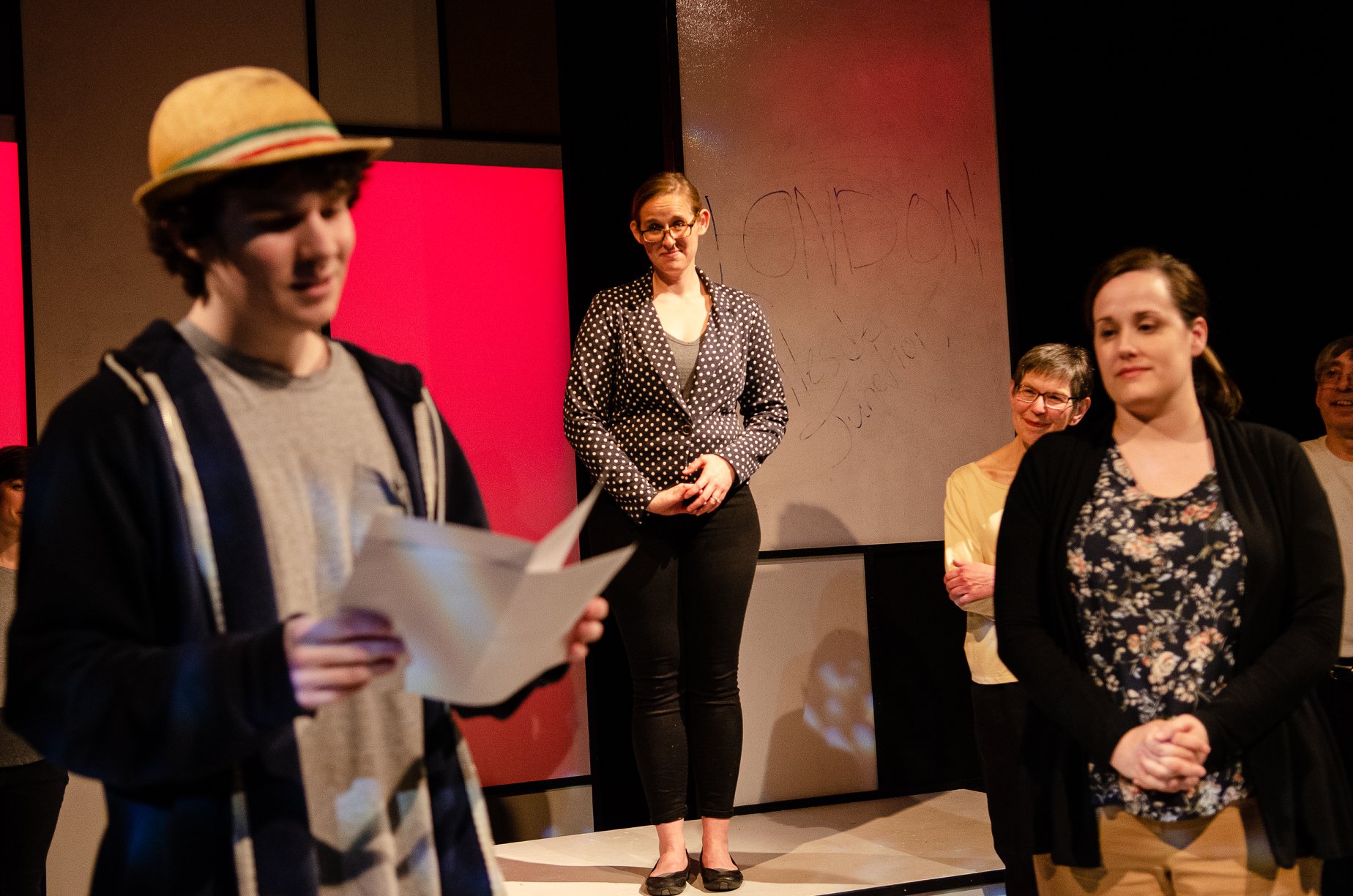"A Curious Incident" Well Worth Investigating
Christopher is honest to a fault. Not because he’s virtuous, but rather because he doesn’t know how to lie. He also doesn’t understand metaphors and he absolutely doesn’t like to be touched, even by his parents. Profoundly affected by his environment, Christopher hates brown and yellow. But when he sees four red cars in a row, that’s a very good day. A gifted math student, when he’s feeling anxious he recites the squares of cardinal numbers.
Christopher is the main character in The Curious Incident of the Dog in the Night-Time, the final play of Strollers’ season, onstage at the Bartell through May 25. Although it’s not explicitly stated in either the book by Mark Haddon or the play adaptation by Simon Stephens, Christopher is neuro-atypical, and would probably be diagnosed on the autism spectrum. Deftly played by teenager Payton Cardella, he is also the heart and soul of the production, directed by Kathleen Tissot.
When the Curious Incident book came out in 2003 it was hailed as a truly original coming of age story -- one told entirely from the perspective of a young man whose brain works very differently other peoples’. When the theatrical version came to Broadway in 2014, audiences marveled at the wildly creative, immersive staging of the story that gave viewers a taste of the challenges Christopher faces navigating his everyday world. By contrast, the Strollers production of Curious Incident is incredibly understated, while still trying to incorporate some of the staging “tricks” of the New York production. The result is uneven.
The play opens with Christopher puzzling over the death of a neighbor’s dog, Wellington, who has been gruesomely killed with a garden fork. Fascinated and frightened by the violence, he vows to solve the mystery of who killed Wellington and why. This leads him to several other mysteries about his parents, their unhappy separation and where exactly he fits into the world.
As the determined but often perplexed Christopher, Cardella does a stellar job of capturing the mannerisms, tics and speech patterns of someone who comprehends the world differently. When speaking to other people he looks briefly in their faces and then looks away. When nervous or impatient, he shifts his weight from one foot to the other and sometimes bounces on the balls of his feet. His fingers play with the zipper and drawstring on his jacket, when they aren’t smoothing the bangs that frame his face. His pacing and intonation is pitch perfect, and Cardella even seems genuinely attached to his character’s pet rat Toby (yes, a real rat) which made some of the other characters and audience members squirm. When Christopher is experiencing sensory overload or emotional anguish, Cardella’s heart wrenching cries emanate from deep inside, evoking empathy for someone who’s hurt instead of disdain for someone who is different.
It would be easy to assume that Cardella’s facility with the character of Christopher comes from the fact the actor has also been diagnosed on the spectrum. While that undoubtedly made it easier for him to identify with the character’s challenges, it shortchanges Cardella’s ability as an actor, which -- displayed here -- is formidable.
As Christopher’s teacher and only dependable ally, Carrie Sweet also turns in a remarkable performance as Siobhan. As a device for the audience to get inside Christopher’s mind, she spends a great deal of time reading entries from his journal, in a way that feels real and free of judgement. Supportive and kind, with a clear-eyed awareness of Christopher’s abilities and limitations, Siobhan’s voice is often in the young man’s head when he needs to calm himself down
Unfortunately the rest of the cast surrounding the unusual main character is not as gifted -- either at mastering the British accent that is necessary for a show that’s so grounded in its location, or at communicating real emotions. Too many of the smaller parts are either executed poorly, or made clumsy by the actors, who stretch out their scenes with pauses and emoting.
In between playing multiple small roles, the cast forms a gray and black clad ensemble that often sits upstage watching the action. Sometimes the group illustrates conversations by carrying props across the stage and other times they morph into set pieces -- subway doors opening and waves splashing. In act 2 they march in formations, representing relentless crowds of people that Christopher must travel through. Although some of the group work was effective, the inconsistency of their roles over the course of the play was simply confusing.
The flexible set, designed by Erin S. Baal, is reminiscent of a Mondrian painting with lots of white squares, and a few of them filled with primary colors. Some of the panels host projections, other white rectangles are actually white boards where the actors can scrawl the name of the setting. It’s a clever device for a play that moves quickly between dozens of locations, but the thin markers failed to make much visual impact.
Under Tissot’s direction the play also felt like a long two hours, fifteen. Pacing was consistently slow, and while the scenes were individually important, they didn’t build to a climax and then resolve.
Fortunately the audience is so taken with Christopher from the first moments of the play that they will follow him wherever he goes, even if it involves asking strangers for directions, eluding police officers, chasing after Toby on a train platform or walking down a brown hallway. His journey through the play is like seeing four red cars in a row. It makes for a good day.
